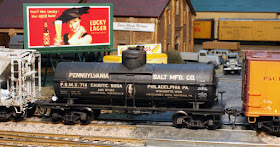I had intended to expand on the comments in Part 14, and have already received an email question about “chemical” tank cars. I will say more on that topic in the present post, along with some additional details.
First, let me emphasize that high-pressure tank cars, ICC Class 105A, have valve bonnets atop the tank, not expansion domes, and they may have or not have platforms around the bonnet. The installation of a platform was up to the individual buyer of the tank car. Many ICC 105A cars did not have platforms, as shown in the AC&F builder photo below:
This is a California Dispatch Line (CDLX) car for liquid ammonia, built in 1948. The white bonnet color had been recommended for LPG cars to assist in rapid return of them to shippers, but some owners of pressure cars chose to paint all bonnets of such cars white. This size of ICC 105A cars could readily carry either cargo seasonally (with appropriate gaskets and valves), and the CDLX fleet did carry both LPG and ammonia.
A few years ago, Atlas produced a model of cars like this, and I use one of their CDLX models to deliver propane to my Associated Oil Company “Flying A” bulk oil dealer. Here is a photo of that model spotted at Associated’s unloading spot. The Empty placard shows the car is ready for pickup.
Before leaving the topic of “chemical” cars, I want to emphasize that chemicals could be and were handled in plain-Jane ICC-103 cars, Type TM, when suitable. An example is this Penn Salt car (an InterMountain 8000-gallon car with a rather elderly paint scheme), which carries a placard for Corrosive cargo. The waybill shows it is carrying concentrated caustic soda, a base rather than an acid, but quite corrosive all the same. The placard warning is essential.
Another tank car type popular with modelers, but not mentioned previously, is the wine tank car. I have two wine shippers on my layout, so these are definitely relevant for me. The classic type to many modelers is the six-compartment car, such as the Precision Scale brass version below. It’s spotted at the Zaca Mesa winery in my layout town of Ballard. For those not familiar with wine as an industrial commodity, I have written a post on exactly that subject (see it at: http://modelingthesp.blogspot.com/2012/02/wine-as-industrial-commodity.html ). There is no placard, as wine is an unregulated commodity. Even the car class is non-ICC, namely AAR 203, restricted to cargoes like wine.
As were the great majority of wine tank cars, this is a 6000-gallon nominal size, about 1000 gallons per compartment. But many wine cars were of one, three or four compartments, so the six-compartment version is only one type of wine car.
The above discussion refers in a few places to placards, and I know this topic is of interest to many modelers, including me. I have written about the use of hazard placards on tank cars, both on the prototype and on model cars, in previous posts. I began by summarizing the history of warning placards on the prototype (up to the transition era); see that post at the following link: http://modelingthesp.blogspot.com/2012/03/tank-car-placards-prototype.html . I followed up on that background with a description of how I model placards in HO scale for my tank car fleet (find it at: http://modelingthesp.blogspot.com/2012/12/tank-car-placards-more-on-modeling.html ). I would refer anyone with curiosity about producing their own placards to consult the second of the two posts just cited.
I will repeat one photo from that second post, to show application of an Empty placard, to cover the Dangerous placard placed by the model manufacturer. I simply apply these with canopy glue. They are exactly 1/8-inch on a side, correct HO scale size for the 10.75-inch size of the prototype placards. (You can click on the image to enlarge if you wish.)
You can also read about model placards in my article in the March 2016 issue of Model Railroad Hobbyist (you can download any issue any time, for free, at their website, www.mrhmag.com ).
To conclude, selection and operation of model tank cars can be a complex topic, but can also be quite interesting and satisfying when you do the research to “get it right.” I continue to strive in that direction with my tank car fleet.
Tony Thompson





No comments:
Post a Comment